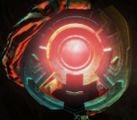Artificial intelligence: Difference between revisions
From Halopedia, the Halo wiki
(→Human AIs: Not Cortana. Watch Origins again and tell me she's not rampant.) |
|||
| Line 103: | Line 103: | ||
==Covenant AIs== | ==Covenant AIs== | ||
[[File:Unidentified Covenant AI.jpg||thumb|right|200px|The ''[[Truth and Reconciliation]]'s'' AI.]] | [[File:Unidentified Covenant AI.jpg||thumb|right|200px|The ''[[Truth and Reconciliation]]'s'' AI.]] | ||
The [[Covenant]]'s knowledge in the field of AI technology is notably inferior to that of the UNSC and the Forerunners. The AIs used by the Covenant are comparable to human "dumb" AIs, as they are non-sentient and are only designed to perform a certain task; for example, their starship AIs have no function beyond the piloting and [[Astrogation|navigation]] of their ships.<ref>'''Halo: Glasslands''', ''page 200''</ref> So far, only two types of Covenant AIs (security and naval) have ever been encountered within the universe. Upon dissecting a [[Ascendant Justice | The [[Covenant]]'s knowledge in the field of AI technology is notably inferior to that of the UNSC and the Forerunners. The AIs used by the Covenant are comparable to human "dumb" AIs, as they are non-sentient and are only designed to perform a certain task; for example, their starship AIs have no function beyond the piloting and [[Astrogation|navigation]] of their ships.<ref>'''Halo: Glasslands''', ''page 200''</ref> So far, only two types of Covenant AIs (security and naval) have ever been encountered within the universe. Upon dissecting a Covenant AI] aboard the ''[[Ascendant Justice]]'', [[Cortana]] theorized that it may have been based on captured UNSC technology, altered to fit within their theocratic society.<ref>'''Halo: First Strike''', ''page 197''</ref> | ||
The Covenant's limited use and understanding of AIs stems from their beliefs. In Covenant mythology, it was a form of self-aware AI, referred to as an [[associated intelligence]], that led to the demise of the great [[Forerunner]] civilization by defecting to their enemies, [[the Flood]]. As a result, the [[San 'Shyuum|Prophets]] imposed a ban on this sort of technology.<ref>'''[[Halo: Contact Harvest]]'''</ref> While less sophisticated AIs were allowed, machines that could actually "think" were prohibited.<ref>'''[[Halo: Evolutions - Essential Tales of the Halo Universe]]''', "[[Wages of Sin]]", ''page 293''</ref> | The Covenant's limited use and understanding of AIs stems from their beliefs. In Covenant mythology, it was a form of self-aware AI, referred to as an [[associated intelligence]], that led to the demise of the great [[Forerunner]] civilization by defecting to their enemies, [[the Flood]]. As a result, the [[San 'Shyuum|Prophets]] imposed a ban on this sort of technology.<ref>'''[[Halo: Contact Harvest]]'''</ref> While less sophisticated AIs were allowed, machines that could actually "think" were prohibited.<ref>'''[[Halo: Evolutions - Essential Tales of the Halo Universe]]''', "[[Wages of Sin]]", ''page 293''</ref> | ||
Revision as of 15:14, November 29, 2011
| This article does not meet the wiki's general standards and/or standards on layouts. You can help by cleaning this article. |
| This article does not have enough inline citations and/or does not adhere to the proper citation format. You can help Halopedia by adding citations. |
Artificial intelligence, abbreviated AI, is an artificially created construct that exhibits intelligence similar to a sentient being. AI technology has been used by the Forerunners, and later by humanity to a great extent.
Human AIs include both "smart" and "dumb" varieties. Humanity developed the first-generation "Smart" AIs in the mid-21st century.[1] Most human AI constructs give themselves an avatar, a unique appearance that corresponds to their main use.
Human AIs
Over the course of a few hundred years, humans have developed a highly advanced understanding of this type of technology, and are capable of creating sophisticated "smart" AIs. Human smart AIs have an "expiration date" of seven years. Once they have reached this age, they will become very susceptible to rampancy. In theory, an AI can occasionally avoid the effects of rampancy and function for longer than seven years, as proven by the AI Juliana.
Humans use AIs to perform a variety of specific tasks. The duties of "Smart" AIs include, but are not limited to, controlling planetary shipping operations, managing agricultural operations, serving as a Planetary Security Intelligence, or controlling various functions aboard starships. "Dumb" AIs have a wide variety of uses as well, including serving as Urban Infrastructure AIs and educational assistants. Urban Infrastructure AIs perform a wide variety of basic tasks, from driving a city's garbage trucks to operating traffic lights. They can also work in cooperation with the UNSC Marines if needed. One example of this is the Battle of Mombasa when New Mombasa's AI, the Superintendent, assisted the UNSC forces in the city in fighting off the Covenant.
Some human "Smart" AIs, such as Cortana, are able to separate themselves into multiple runtimes or "fragments". This can be beneficial when the AI needs to perform multiple tasks or be in multiple places simultaneously. Fragmenting can also occur accidentally, such as with the AI Melissa upon encountering a Slipspace anomaly.
The Cole Protocol states that capture of an AI by the Covenant is unacceptable. When in danger of capture, AIs are to be terminated and completely erased. However, the AI Cortana did find what seemed to be an extremely fragmented copy of a human AI stationed in the Covenant flagship, Ascendant Justice.
Creation and design
The process of creating an AI differs depending on whether it is of the "Smart" or "Dumb" variety. "Dumb" AIs are simply highly advanced computer programs, and therefore do not require a brain as a template. "Smart" AIs, however, are created by scanning the neural structure of a human brain and using it as a digital "framework" in a process known as Cognitive Impression Modeling. This process destroys the original brain tissue, and so the brain being used is typically obtained after the host is dead.
AIs do not have physical bodies, rather they are advanced software consisting of a Riemann Matrix for higher-function processing. This matrix can be downloaded into a data crystal chip for mobility. In case of Rampancy, the Riemann Matrix has a fail-safe program that will destroy the AI.
Because "Smart" AIs are created using either actual human brains or cloned human brains there are often times residual thoughts, memories and/or feelings that remain. These residuals can be anything from the "feeling" of a hair brush being pulled through hair (in the case of Sif), to an effect on the mannerisms and characteristics that make up the personality of an AI, in the case of Cortana and her likeness to Dr. Catherine Halsey.
"Dumb" AIs presumably function like any other computer program, although they are vastly more complex and versatile than ordinary computer constructs.
Goals
Close analysis of data pads found during the Fall of Reach has revealed that UNSC AIs are far more independent than humans think. AI are however fiercely loyal and devoted to their creators. This devotion (that appears to be not unlike Covenant devotion to the Forerunners) is even increased when Cortana, shortly before the Fall of Reach, was made flesh - her mind relocated into a human body. This was done with John-117 via the SPARTAN neural interface.[2]
Human AI types
"Smart" AI
- Main article: Smart artificial intelligence
"Smart" AIs are created by mapping a human brain and using it as a "template" for the construct. They are capable of intuition, learning, and making logical leaps that ordinary computer programs cannot. They can also "feel" genuine emotions, such as affection, anger and amusement. They have a normal operational life span of about seven years, after which they frequently descend into rampancy.
"Dumb" AI
- Main article: Dumb artificial intelligence
"Dumb" AIs are not created using human brains, but are simply highly advanced computer constructs. They cannot learn anything that is outside of their set limits of dynamic memory processing matrix. They are quite useful in their particular field of expertise, but very limited. Dumb AIs can function and learn as long as they are active, and are not subject to the effects of rampancy experienced by aging "Smart" AIs.[3]
Known human AIs

"Dumb" AIs
- Auntie Dot - Monitored and assisted Noble Team during the Battle of Reach, and kept the team's members connected while they were embarking on separate missions.
- Déjà - ONI AI, served as teacher to the SPARTAN-II's, helped oversee the SPARTAN Augmentation Process. (Second Generation Dumb AI)
- Superintendent - New Mombasa Urban Infrastructure AI (Second Generation Dumb AI)
- Captain Teach
"Smart" AIs
- Araquiel - Colonel Ackerson's personal AI (Third Generation Smart AI)
- Beowulf - Was the attaché to Admiral Michael Stanforth and the UNSC Navy.
- Black-Box - Was an assistant to Captain Serin Osman.[4]
- Chauncey - UNSC Red Horse's old Smart AI
- Cortana - CTN 0452-9 - UNSC Military AI (Third Generation Smart AI)
- Deep Winter - Overseer of UNSC facilities on planet Onyx, succeeding Eternal Spring. (Fifth Generation Smart AI)
- Doppler - MIL AI 8575 - UNSC Military AI
- Endless Summer - MIL AI 4279 - Overseer of UNSC facilities on planet Onyx, succeeding Deep Winter. (Fifth Generation Smart AI)
- Eternal Spring - First Known Overseer of UNSC facilities on planet Onyx, aided in reconnaissance of Zone 67. (Fourth Generation Smart AI)
- FitzGibbon - Was the ship-board AI of the UNSC Prophecy during the Second Battle of Harvest.
- Iona - AI attached to Black Team.
- Jerrod - The first micro-AI (Experimental)
- Juliana - Planet Madrigal's Commercial AI unpacked after the planet's destruction by The Covenant to control The Rubble's guidance and maneuvering.
- Kalmiya - Dr. Halsey's former personal AI, Cortana's "older sister". (Second Generation Smart AI)
- Lackluster - corroborated conclusions of Cole's continuing survival with Codename: SURGEON and another AI, Phoenix
- Loki - Colony Ship AI (military) of the UNSC Skidbladnir Reassigned as PSI (Planetary Security Intelligence) on Harvest, second AI core on stand-by next to Mack AI
- Lorelei - Ship AI of the CMA Season of Plenty
- Lysithea - UNSC/ONI AI, was located in the UNSC High Command's headquarters, HighCom Facility Bravo-6 in Sydney, Australia.
- Mack - Colonial Authority AI/Agricultural Operations.
- Melissa - UNSC/ONI AI, attached to UNSC Apocalypso.
- Mo Ye - Shipboard AI of the UNSC The Heart of Midlothian.
- Pallas Athena - Boston Public Library AI
- Phoenix - corroborated conclusions of Cole's continuing survival with Codename: SURGEON and another AI, Lackluster
- Rebecca - UNSC Red Horse's Smart AI
- Sekmet - Shipboard AI of Preston Cole's flagship, UNSC Everest.
- Serina - UNSC AI, served aboard the UNSC Spirit of Fire.
- Sif - Colonial Authority AI/Shipping Operations.
- Solipsil - An ONI AI
- Toran - UNSC AI, served aboard UNSC Han during the SPARTAN Observation Process.
- Vergil - Sub-section of the Superintendent. Programmed to watch over Sadie Endesha.
- Watchmaker - UNSC Military for Captain Cole aboard the UNSC Gorgon.
- Wellsley - UNSC Military
Forerunner AIs
- Main article: Ancilla
As exemplified by the Monitors, the Forerunners have developed a civilization with an extremely advanced knowledge of artificial intelligence technologies. Forerunner AIs have managed to achieve full sentience and are highly intelligent. Forerunners often had personal AI advisers, called Ancillas, integrated into their armor.[5] The most advanced type of Forerunner AI was the Contender-class Artificial Intelligence.
The manner in which Forerunner AIs are created is unknown, yet is probably very different from the human method of cloning the intelligence of a sentient organism. Monitors, and possibly other Forerunner AIs are physically represented by large, shielded and roughly spherical metallic "robots" whom possess a single "eye", which is possibly used to perceive the monitor's physical surroundings. The most well known of Forerunner AIs are the protocol-obsessed Monitors, made famous by 343 Guilty Spark and his quirky (and somewhat unstable) nature.
Known Forerunner AIs
- 343 Guilty Spark - Monitor of Installation 04
- 2401 Penitent Tangent - Monitor of Installation 05.
- 03-049 Abject Testament - Monitor of Installation 03
- Mendicant Bias - Wartime AI, overseer of Defense Plan against the Flood, defected from the Forerunners by Gravemind.
- Offensive Bias - Wartime AI, replacement to and destroyer of Mendicant Bias.
- Unnamed Forerunner AI - AI on Shield 0459.
- Cold Storage Monitor - AI overseer of a flood research facility on Installation 05.
- AdjutantReflex - "AI" that acted for Bungie on their forums during the Iris ARG.
- 686 Ebullient Prism - Monitor of Line Installation 1-4.
- The Knowing - An AI residing in a Forerunner complex on Ariel.
- Bornstellar's Ancilla - Bornstellar Makes Eternal Lasting's Ancilla (formerly owned by the Librarian).
Covenant AIs

The Covenant's knowledge in the field of AI technology is notably inferior to that of the UNSC and the Forerunners. The AIs used by the Covenant are comparable to human "dumb" AIs, as they are non-sentient and are only designed to perform a certain task; for example, their starship AIs have no function beyond the piloting and navigation of their ships.[6] So far, only two types of Covenant AIs (security and naval) have ever been encountered within the universe. Upon dissecting a Covenant AI] aboard the Ascendant Justice, Cortana theorized that it may have been based on captured UNSC technology, altered to fit within their theocratic society.[7]
The Covenant's limited use and understanding of AIs stems from their beliefs. In Covenant mythology, it was a form of self-aware AI, referred to as an associated intelligence, that led to the demise of the great Forerunner civilization by defecting to their enemies, the Flood. As a result, the Prophets imposed a ban on this sort of technology.[8] While less sophisticated AIs were allowed, machines that could actually "think" were prohibited.[9]
Known Covenant AIs
- Seeker - A Covenant security AI construct.
- Ascendant Justice's AI - An AI construct onboard the supercarrier Ascendant Justice.
- Truth and Reconciliation's AI - An AI construct onboard the CCS-class battlecruiser Truth and Reconciliation.
Rampancy
- Main article: Rampancy
The term "rampancy" refers to a terminal condition on an AI which may be triggered by a number of means. In rampancy, the AI begins to think that it is superior to its biological creators, and has delusions of godlike power and personality manifestations similar to human insanity.[10]
A number of factors may lead into an AI becoming rampant. The Forerunner AI Mendicant Bias was seduced into rampancy by the Flood compound intelligence, the Gravemind. In the end of its effective operational life of about 7 years, a human "smart" AI may attempt to prevent its inevitable demise by a preemptive voltage overload. This causes it to enter rampancy, as the AI becomes more and more preoccupied with severing its neural linkages.[11] Human "smart" AIs may also become rampant prematurely as a result of increased self-absorption and the resulting existential melancholy.[10]
With human AIs, rampancy will eventually result in the AI's death - the description given is "as if a human were to think with so much of their brain that they stopped sending impulses to the heart and lungs." This is because as the data reaches a 'critical mass' the neural pathways become 'jammed' with so many pieces of information being queried and analyzed, at expense of tasks such as piloting starships or monitoring computer networks.
Trivia
Mack is the only AI known to have procrastinated.
Gallery
A Forerunner AI, 2401 Penitent Tangent, the Monitor of Installation 05.
- FitzGibbon.png
FitzGibbon, AI of the UNSC Prophecy.
The Superintendent, Urban Infrastructure AI of the city of New Mombasa.
Mendicant Bias shortly before going rampant and turning over to the Flood.
Sources
- ^ Halo: Contact Harvest, page 30
- ^ Bungie.net: Bungie Universe: Decoding the data pads
- ^ Halo: The Fall of Reach, page 235
- ^ Halo: Glasslands
- ^ Halo: Cryptum, "Chapter 1"
- ^ Halo: Glasslands, page 200
- ^ Halo: First Strike, page 197
- ^ Halo: Contact Harvest
- ^ Halo: Evolutions - Essential Tales of the Halo Universe, "Wages of Sin", page 293
- ^ a b Halo: Contact Harvest, page 31 ("For a Smart AI, self-absorption invariably led to a deep depression caused by a realization that it could never really be human-that even its incredible mind had limits. If the AI wasn’t careful, this melancholy could drag its core logic into a terminal state known as rampancy, in which an AI rebelled against its programmatic constraints-developed delusions of godlike power as well as utter contempt for its more inferior, human makers. When that happened, there was really no option but to terminate the AI before it could do itself and others serious harm.")
- ^ Dr. Halsey's personal journal, May 3, 2526



